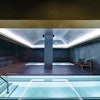A host of advances in the production of glass is bringing more light more safely into sports and recreation buildings.
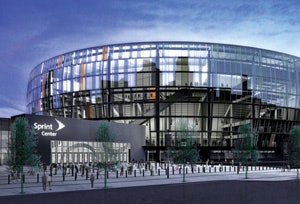
Jon Niemuth, a design principal with Kansas City-based Ellerbe Becket, notes that it was during the design phase of the firm's earlier professional basketball venue, Charlotte Bobcats Arena, when the NBA issued new facility design guidelines meant to respond to the heightened terrorist threat posed by the events of 2001.
"An addendum to those guidelines included anti-terror blast-resistive capabilities, and if we were to follow those recommendations to the letter, no one would be able to get within 100 yards of the building, and you'd literally have brick from grade to 30 feet," Niemuth says. "The recommendations were just not conducive to good urban design; those are not the kinds of buildings, arena or otherwise, that you want to put in the middle of cities. So now what do you do?"
What you don't do is follow the recommendations to the letter. Obviously, you must design your buildings with security in mind, following established principles such as CPTED (Crime Prevention Through Environmental Design). Otherwise, though, you continue the pre-9/11 trend toward increased openness and daylighting, using generous amounts of glass - because state-of-the-art glass allows it.
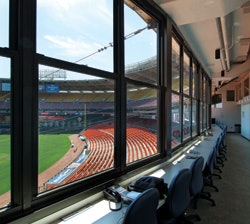
So what, if anything, has changed? Glass has. First came low-E coated glass that allowed light to penetrate but limited the amount of solar radiation. Then came double-paned glass units that were as well insulated - sometimes better insulated - than the walls that held them. Tempered glass units are now engineered to be strong enough to withstand the heat of open flames, the pressure from high winds and the direct strikes of birds, branches and baseballs. (And when tempered glass breaks, it's into pebbles of glass, not shards.) Finally, by filling the gap between panes with a thick, clear, flexible polyvinyl butyral film, glass can almost breathe and flex, and remain in place even after breaking. Automobile windshields are both tempered and laminated, and the standard for auto safety is now the standard for building safety.
Tim Casai, a principal with Bloomfield Hills, Mich.-based TMP Associates Inc., speaks of a wall's "impact zone" in school sports facilities and college and community recreation centers, saying, "We try to use materials that are somewhat bulletproof, metaphorically." Actually, he means it almost literally. Stadium press boxes and luxury suites - incredibly, it sometimes seems - are faced with large glass units that can withstand a direct hit by a batted ball. Natatoriums feature floor-to-ceiling glass that doesn't shatter even when struck by a water polo ball. School hallways and gyms, and racquet courts besides, feature glass walls that flex but don't break when hit by a running athlete or shoved student. And then there are ticket booth windows that protect workers and the day's take with multiple layers of glass actually designed to stop bullets.
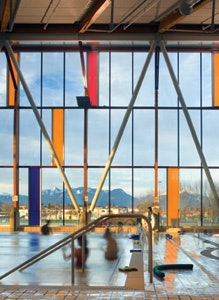
Another cost consideration involves bringing the building up to the standards of the glass. As Nachtscheim notes, HNTB's federal clients insist that the firm meet U.S. Army Corps of Engineers requirements that specify blast-worthiness for all building components. "In those types of applications," he says, "we're required to use special laminated glass with frames that are bolted into the superstructure so that even the frames won't blow out if somebody detonates a bomb in front of the place."
It's worth noting that for all the added strength of state-of-the-art glass units, the purpose of safety glass in the event of an explosion is not to resist damage, but to allow the building to survive the impact and sustain itself long enough for people inside to get out, and for first responders to get in. The same is true of fire-resistant glass, which has become the preferred replacement for the wired glass that was for many years the standard in school applications. Fire-resistant glass comes in two distinct types: Silica glass, which expands when heated (flying glass is prevented, again, by the vinyl interlayer), and ceramic glass, which does not expand when exposed to heat. Neither type will blow out in a fire, thereby halting the spread of flames through window openings. However, Len Brunett, president of glass manufacturer Vetrotech Saint-Gobain N.A. in Auburn, Wash., and chair of the Fire Safety Glazing Council's Committee on Education, notes that the same transfer of heat that makes ceramic glass perfect for stovetops renders it incapable of preventing the spread of radiant heat in a burning building. Therefore, he says, special care should be taken when considering these products, since ratings specifying the number of minutes a product is rated for "fire protection" might not take into account the dangerous condition of radiant heat.
This circumstance troubles Greg Abel of Advocates for Safe Glass, whose crusade against wired glass has led to a number of legislative and code changes across the country (see "Closing the Door on Wired Glass," July 2004, p. 11). Though an unabashed proponent of replacing wired glass at all costs, Abel now fears that the risk of building occupants being sliced by wired glass could simply be traded for a risk of burning them. "With some of these high-performance products, even though they offer a higher performance with regard to fire, they don't necessarily offer higher performance with regard to impact safety, or as a barrier to radiant heat," Abel says. "That's why we need to continue to educate code officials and architects regarding the appropriate use of glazing."
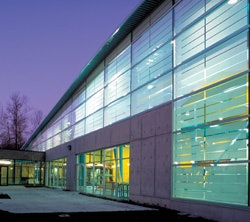
Schools in the post-9/11 world are undergoing a similar transformation, with glassed vestibules and single points of entry bringing the principal's office closer to the role of the community rec center's check-in desk. "It's a simple concept: It's important to be able to see what's coming," says Casai. "You've been to enough schools in your life to know that you walk in some side door, and all of a sudden you're asking yourself, 'Where in the hell's the gym?' We're now designing a single point of entry and using ample amounts of glass to allow administrators to see anyone in the act of approaching and entering the building. It's really only in the past five years that these issues have been talked about in the K-12 community."
About the only thing limiting such changes is a shortage of funds - or, more accurately, building owners' hesitance to spend available funds on security-related measures. While the cost of state-of-the-art window units has come down considerably, it is still more expensive than concrete block. As Niemuth says about arenas, "Safety precautions are real and valid, but there's just never enough in the budget to take that hit. Less than a quarter of the budget goes to doing the exterior enclosure, so it's not a lot of money to start with."
It's true, too, that using more glass adds to costs in ways that sometimes take building owners by surprise. For instance, should a tempered, laminated unit break, it must be replaced immediately for aesthetic as well as security reasons. Since specialized glass is produced in multiple steps - first tempered, then UV-coated, then laminated - it is not readily available for quick replacement, meaning that building owners must purchase and stock extra glass units for emergency use. In addition, arena owners who opt for generous glass in the exterior concourse but still intend for their building to host musical and theatrical acts must then spend additional monies on blackout curtains at vomitories and sometimes over exterior windows if there is a chance that daylight will leak from the exterior into the seating bowl.
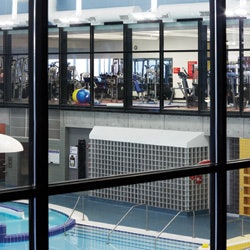
Concerns about costs are leading some building owners (especially school systems) to strengthen and protect existing glass with a coated film rather than replace older window units. While improvements have also been made to these products, many architects are still hesitant to use them in high-visibility areas because of possible scratches and scrapes from people inside buildings and wind-borne particulate matter outside. "It's cheaper than laminated glass, and while we've added film on a number of projects, most of the time it has been in hands-off applications such as elevator shafts," says Nachtscheim. "I can't imagine we'd ever use it in a sports facility where it can be damaged by human contact."
Interestingly, building owners seem more willing to take on the added expenses associated with glass if the reason is either aesthetic or environmental - or both. Making the case for either is not difficult, as new units' double-pane construction and low-E coatings give them energy efficiency, while the vinyl interlayer allows for colors and patterns to be added within the pane that can't be marred by human contact. Ceramic frits can be baked onto the glass surface that act as a shading mechanism, cutting down unwanted glare in natatoriums and gyms. In spectator venues, new glass that has an anti-reflective coating applied to cut down on glare in press boxes and luxury suites is easy for most building owners to justify economically.
"The interlayers in particular have made a big difference in what you're able to do - whether for solar control, UV control, insulative qualities, shading capabilities, solar collection by grafting photovoltaics onto the units, colors and designs - it's so sophisticated now," says Niemuth. "People now want these buildings to be good buildings. There was a time when it was fine for there to be no windows on the exterior of a sports building; nobody cared. But now you put a dark box in an entertainment environment, and people just won't tolerate it. They want a different character of architecture than they did 15 years ago."











